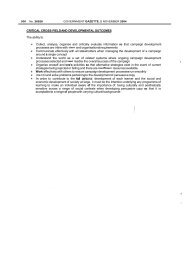Macroeconomic strategies, agriculture and rural poverty in post ...
Macroeconomic strategies, agriculture and rural poverty in post ...
Macroeconomic strategies, agriculture and rural poverty in post ...
Create successful ePaper yourself
Turn your PDF publications into a flip-book with our unique Google optimized e-Paper software.
targets agro-<strong>in</strong>dustry, creates new jobs <strong>and</strong> improves <strong>rural</strong> livelihoods, accord<strong>in</strong>g to Merg, has<br />
the potential of stimulat<strong>in</strong>g the economy as a whole:<br />
Dynamic <strong>in</strong>teractions may be anticipated between exp<strong>and</strong>ed dem<strong>and</strong> <strong>in</strong><br />
the agricultural sector, <strong>in</strong>creased agro-<strong>in</strong>dustry output <strong>and</strong> <strong>in</strong>creased<br />
output from a range of other manufactur<strong>in</strong>g sub-sectors. Grow<strong>in</strong>g<br />
output <strong>and</strong> rates of capacity utilisation, especially <strong>in</strong> the food process<strong>in</strong>g<br />
components of agro-<strong>in</strong>dustry should lower the real price of basic goods,<br />
result<strong>in</strong>g <strong>in</strong> an <strong>in</strong>crease <strong>in</strong> the proportion of their <strong>in</strong>comes that the mass<br />
of the <strong>rural</strong> population can devote to the purchase of manufactures<br />
(Merg 1993, 170).<br />
The International Labour Office’s (ILO) report on labour markets <strong>in</strong> South Africa has<br />
pursued this argument <strong>in</strong> more detail, but also <strong>in</strong> the context of a better underst<strong>and</strong><strong>in</strong>g of<br />
<strong>rural</strong> <strong>poverty</strong> <strong>and</strong> <strong>rural</strong> livelihoods (St<strong>and</strong><strong>in</strong>g et al 1996). Us<strong>in</strong>g the PSLSD data, as well as<br />
other surveys which seem more representative of the <strong>in</strong>come earn<strong>in</strong>g <strong>strategies</strong> of the <strong>rural</strong><br />
poor, they support Merg’s emphasis on <strong>rural</strong> job creation <strong>and</strong> the possibilities it has for the<br />
economy as a whole. The recent surveys suggest that <strong>in</strong>come from agricultural wage<br />
employment - however poorly paid <strong>and</strong> <strong>in</strong>secure - rema<strong>in</strong>s the most important livelihood<br />
strategy for the <strong>rural</strong> poor <strong>and</strong> especially <strong>rural</strong> women. Income generated from the <strong>in</strong>formal<br />
sector <strong>and</strong> from farm<strong>in</strong>g represent a negligible portion of the total <strong>in</strong>come earned by poor<br />
<strong>rural</strong> households. The PSLSD profile of the households that do earn an <strong>in</strong>come from<br />
farm<strong>in</strong>g is very significant. It suggests that those households mak<strong>in</strong>g money from <strong>agriculture</strong><br />
also earn <strong>in</strong>come from the primary labour market, <strong>in</strong> other words jobs that are relatively<br />
secure <strong>and</strong> well paid. In contrast, the poorest <strong>rural</strong> households are unable to generate <strong>in</strong>come<br />
from agricultural production <strong>and</strong> rely <strong>in</strong>stead on wage <strong>in</strong>come from farm work or domestic<br />
service (May, Carter <strong>and</strong> Posel 1995). The importance of <strong>rural</strong> wage work is given further<br />
weight by the f<strong>in</strong>d<strong>in</strong>g that remittances to <strong>rural</strong> households come ma<strong>in</strong>ly from wages earned<br />
with<strong>in</strong> <strong>rural</strong> areas. This overturns the conventional wisdom that remittances to <strong>rural</strong><br />
households are transferred from wage earners located <strong>in</strong> the ma<strong>in</strong> metropolitan areas <strong>and</strong><br />
strengthens the case for a policy which improves <strong>rural</strong> employment opportunities.<br />
The Merg/ILO approach depends, of course, on improv<strong>in</strong>g work<strong>in</strong>g conditions <strong>in</strong> <strong>rural</strong><br />
areas <strong>and</strong> especially employment practices on white commercial farms. While workers <strong>in</strong><br />
agro-process<strong>in</strong>g <strong>in</strong>dustries <strong>and</strong> forest plantations are often organised <strong>and</strong> enjoy competitive<br />
wages <strong>and</strong> adequate work<strong>in</strong>g conditions, wages for farm workers are notoriously low, work<strong>in</strong>g<br />
hours extend beyond the legal limit, <strong>and</strong> violence rema<strong>in</strong>s a form of coercion on some farms.<br />
On farms <strong>in</strong> the former bantustans conditions are variable: while sugar cane farmers <strong>in</strong> the<br />
Mpumalanga lowveld pay wages to farm labour <strong>and</strong> apparently have ‘good relations’ with<br />
their workers (Vaughan <strong>and</strong> McIntosh 1995), <strong>in</strong> other regions of the country, conditions are<br />
worse <strong>and</strong> payment <strong>in</strong> k<strong>in</strong>d appears to be the most common form of remuneration. The<br />
recent extension of the Labour Relations Act (LRA) to farm workers has focused attention<br />
on the possibilities of organis<strong>in</strong>g farm workers with a view to improv<strong>in</strong>g work<strong>in</strong>g conditions<br />
<strong>and</strong> wages (Murphy 1995). Unfortunately, the experience of unions has been disappo<strong>in</strong>t<strong>in</strong>g:<br />
it has proved extremely difficult to organise farm workers <strong>in</strong> the context of high <strong>rural</strong><br />
unemployment, <strong>and</strong> farmer reluctance to permit organisers access to workers. The South<br />
African Agricultural Union <strong>and</strong> the National Department of Agriculture have come out<br />
aga<strong>in</strong>st labour legislation, argu<strong>in</strong>g that it will encourage farmers to decrease the number of<br />
workers on farms <strong>and</strong> accelerate the trend away from maize production (Nampo 1993;<br />
Department of Agriculture 1996). And while the LRA may make it easier for unions to<br />
organise workers, commercial farmers rema<strong>in</strong> protected by pieces of legislation like the<br />
Trespass Act, which they can use to evict union organisers from their l<strong>and</strong>. Those farms that<br />
5

















